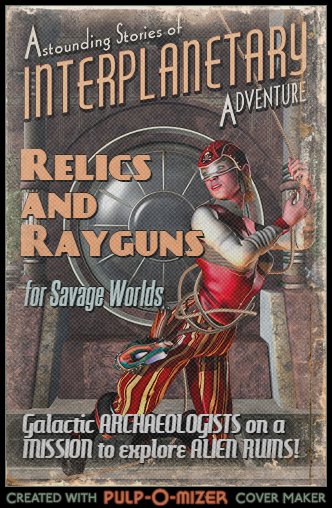This week, Happy Monster began playtesting on our new setting, Relics and Rayguns! This new setting combines science fiction with dungeon delving, all against a backdrop of social media gone galactic. In other words, Indiana Jones on Twitch in space!
Here’s an excerpt from the draft setting book:
Relics and Rayguns is set in a far future in which humanity and millions of other races inhabit the galaxy, but rarely interact in person because of the expense and limitations of faster-than-light space travel. Instead, quantum-entanglement communications systems (“tangle-comms”) connect worlds in infospace, allowing near-real-time exchange of ideas, virtual interaction, and shared experiences.
A few intrepid souls do make the journeys between stars, however; these explorers travel by tunneling through wormholes generated from their ships and connected to “exit nodes” scattered across the galaxy. Wormhole ships have strict upper limits on mass and diameter, which severely constrains their usefulness for trade. Happily, however, these same limits, combined with the high cost of the wormhole generation systems, make interstellar warfare completely impractical.
With large-scale travel between stars impossible, most civilized solar systems are densely populated, with settlements on any reasonably-habitable world. Different races have different priorities for how they spend their time, but most societies operate in a post-scarcity model where everyday items are readily available. Many people spend much of their time online, sharing experiences recorded by adventurers or daredevils who risk their lives for fame – because fame brings with it enormous material rewards, as citizens donate some of their allowance of “omniprinter” fabrication time to support their favorite Gridcast stars. Over time, the fandoms of particular adventurers become cultures unto themselves, often more important than one’s species or homeworld.
Despite the post-scarcity technology in the galaxy, a few items are difficult to create, notably the Type II piezogravitational crystals used for both wormhole generators and shipboard quantum resonance reactors. These crystals incorporate stable transuranic elements that require time and expensive equipment to manufacture, limiting the available supply of ships. Type I crystals, on the other hand, are readily available, providing anti-gravity cars and flight packs among other marvels, and powered by hypercapacitors – compact, high capacity energy storage devices.
The exit nodes, as well as many other technological wonders, come from an ancient race known as the Founders. The Founders left behind artifacts and installations in many solar systems and on many worlds, and one of the main reasons for interstellar travel is to locate and explore these remnants. Node prospectors tunnel blind to unmapped exits, looking for new technologies and wonders to make their fortune. Sometimes, they never tunnel back.
Characters in Relics and Rayguns are trying to make their way in the galaxy as node prospectors. They will need to find a ship, make sure they have the right expertise in their crew, and strike out into the unknown. There are still dragons in the map margins, and blind tunneling is a risky business in many ways, including competition from other prospectors who may not want to share their discoveries.
In Session Zero, the players and I worked out a number of details in addition to creating characters. We began by completing individual copies of Monte Cook’s Consent in Gaming form, a resource I recommend to any GM, especially anyone running games at conventions where they may not know the players well. The form allows players (and GMs) to identify any potential issues that might cause an undesired or problematic reaction at the table, so that they can be addressed (if appropriate to the story) or avoided (if unnecessary). Issues range from arachnophobia to racism, covering a variety of topics that might disrupt play.
Next, we set some table rules. As all of the playtesters are veterans of the Happy Monster table, we didn’t have too much to discuss other than a rise in the use of phones at the table – we agreed to put them away during play.
Finally, we generated characters. Certain archetypes – pilot, astrogator, engineer – are vital to wormhole jump operations in Relics and Rayguns, and some others – medic, guard, archaeologist/Founder specialist – are very useful. We ended up with one of each, with some backups. We’ll have more detailed blog posts on the characters later, but to start off, we have:
- Ben: Octopus-like alien archaeologist, hacker, and member of the FounderNet fandom, which trades conspiracy theories and mad guessing about the ancient aliens.
- Brian: Strange tentacled alien astrogator, who felt like a weakling among his normally tough and aggressive race, and wanted to get out in the galaxy and away from home.
- Erik: Alien resembling a six-foot tardigrade; a medic who doesn’t believe in cybernetics or bioware for himself but is happy to work on them in others, and a bit of a prankster.
- Lara: Alien housecat and ace pilot who believes that her species was descended from dragons, and intends to find them out in the galaxy.
- Lillie: Catgirl (friend of the housecat) and Junker fandom gadgeteer (and ship’s engineer) with a short temper and a chip on her shoulder.
- Steve: Strange alien that cannot survive for long outside his environment suit because of his species’ attempts at genetic engineering for prolonged life; armed and dangerous fighter and expert shot.
Stay tuned to the blog for the adventures of this motely crew as they meet and then head out into the galaxy!


Leave a Reply